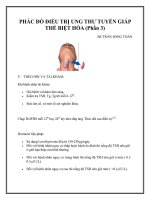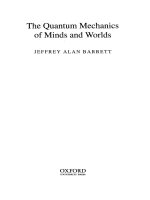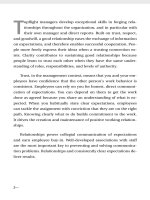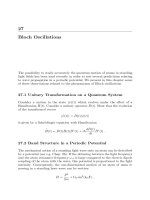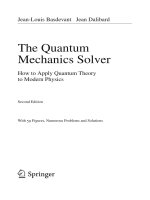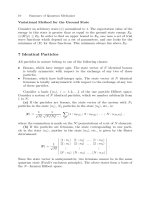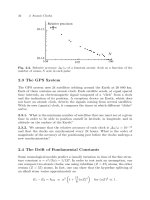- Trang chủ >>
- Khoa Học Tự Nhiên >>
- Vật lý
The Quantum Mechanics Solver 3 docx
Bạn đang xem bản rút gọn của tài liệu. Xem và tải ngay bản đầy đủ của tài liệu tại đây (190.06 KB, 10 trang )
10 Summary of Quantum Mechanics
Variational Method for the Ground State
Consider an arbitrary state |ψ normalized to 1. The expectation value of the
energy in this state is greater than or equal to the ground state energy E
0
:
ψ|
ˆ
H|ψ≥E
0
. In order to find an upper bound to E
0
, one uses a set of trial
wave functions which depend on a set of parameters, and one looks for the
minimum of E for these functions. This minimum always lies above E
0
.
7 Identical Particles
All particles in nature belong to one of the following classes:
• Bosons, which have integer spin. The state vector of N identical bosons
is totally symmetric with respect to the exchange of any two of these
particles.
• Fermions, which have half-integer spin. The state vector of N identical
fermions is totally antisymmetric with respect to the exchange of any two
of these particles.
Consider a basis {|n
i
,i=1, 2, } of the one particle Hilbert space.
Consider a system of N identical particles, which we number arbitrarily from
1toN.
(a) If the particles are bosons, the state vector of the system with N
1
particles in the state |n
1
, N
2
particles in the state |n
2
, etc., is:
|Ψ =
1
√
N!
1
√
N
1
!N
2
! ···
P
|1:n
P (1)
;2:n
P (2)
; ; N : n
P (N)
,
where the summation is made on the N! permutations of a set of N elements.
(b) If the particles are fermions, the state corresponding to one parti-
cle in the state |n
1
, another in the state |n
2
, etc., is given by the Slater
determinant:
|Ψ =
1
√
N!
|1:n
1
|1:n
2
|1:n
N
|2:n
1
|2:n
2
|2:n
N
.
.
.
.
.
.
.
.
.
|N : n
1
|N : n
2
|N : n
N
.
Since the state vector is antisymmetric, two fermions cannot be in the same
quantum state (Pauli’s exclusion principle). The above states form a basis of
the N−fermion Hilbert space.
8 Time-Evolution of Systems 11
8 Time-Evolution of Systems
Rabi Oscillation
Consider a two-level system |±, of Hamiltonian
ˆ
H
0
=¯hω
0
|++|. We couple
these two states with a Hamiltonian
ˆ
H
1
:
ˆ
H
1
=
¯hω
1
2
e
−iωt
|+−| +e
iωt
|−+|
.
We assume that the state of the system is |− at time t = 0. The probability
to find the system in the state |+ at time t is:
P (t)=
ω
2
1
Ω
2
sin
2
(ΩT/2) with Ω
2
=(ω − ω
0
)
2
+ ω
2
1
.
Time-Dependent Perturbation Theory
We consider a system whose Hamiltonian is
ˆ
H(t)=
ˆ
H
0
+
ˆ
H
1
(t). We assume
the eigenstates |n of
ˆ
H
0
and the corresponding energies E
n
are known. At
time t = 0, we assume that the system is in the eigenstate |i of
ˆ
H
0
.Tofirst
order in
ˆ
H
1
, the probability amplitude to find the system in another eigenstate
|f at time t is:
a(t)=
1
i¯h
t
0
e
i(E
f
−E
i
)t/¯h
f|
ˆ
H
1
(t
)|i dt
.
In the case of a time-independent perturbation H
1
, the probability is:
P (t)=|a(t)|
2
=
1
¯h
2
f|
ˆ
H
1
|i
2
sin
2
(ωt/2)
(ω/2)
2
,
where we have set ¯hω = E
f
− E
i
.
Fermi’s Golden Rule and Exponential Decay
Consider a system with an unperturbed Hamiltonian
ˆ
H
0
. Initially, the system
is in an eigenstate |i of energy E
i
. We assume that this system is coupled to
a continuum {|f} of eigenstates of
ˆ
H
0
by the time-independent perturbation
ˆ
V . For simplicity, we assume that the matrix elements f|
ˆ
V |i only depend
on the energies E
f
of the states |f.
To lowest order in
ˆ
V , this coupling results in a finite lifetime τ of the state
|i: the probability to find the system in the state |i at time t>0ise
−t/τ
with:
1
τ
=
2π
¯h
|f|
ˆ
V |i|
2
ρ(E
i
) .
The matrix element f|
ˆ
V |i is evaluated for a state |f of energy E
f
= E
i
.
The function ρ(E) is the density of final states. For non relativistic particles
12 Summary of Quantum Mechanics
(E = p
2
/2m) or ultra-relativistic particles (E = cp, for instance photons), its
values are respectively:
ρ
non rel.
(E)=
mL
3
√
2mE
2π
2
¯h
3
ρ
ultra rel.
(E)=
L
3
E
2
2π
2
¯h
3
c
3
.
When the spin degree of freedom of the particle comes into play, this density of
state must be multiplied by the number of possible spin states 2s +1,where
s is the spin of the particle. The quantity L
3
represents the normalization
volume (and cancels identically with the normalization factors of the states
|i and |f ). Consider an atomic transition treated as a two-level system,
an excited state |e and a ground state |g, separated by an energy ¯hω and
coupled via an electric dipole interaction. The lifetime τ of the excited state
due to this spontaneous emission is given by:
1
τ
=
ω
3
3π
0
¯hc
3
e|
ˆ
D|g
2
,
where
ˆ
D is the electric dipole operator.
9 Collision Processes
Born Approximation
We consider an elastic collision process of a non-relativistic particle of mass
m with a fixed potential V (r). To second order in V , the elastic scattering
cross-section for an incident particle in the initial momentum state p and the
final momentum state p
is given by:
dσ
dΩ
=
m
2π¯h
2
2
|
˜
V (p −p
)|
2
, with
˜
V (q)=
e
iq·r/¯h
V (r) d
3
r.
Example: the Yukawa potential. We consider
V (r)=g
¯hc
r
e
−r/a
,
which gives, writing p =¯hk:
dσ
dΩ
=
2mgca
2
¯h
2
1
1+4a
2
k
2
sin
2
(θ/2)
2
(Born) ,
where θ is the scattering angle between p and p
. The total cross-section is
then:
σ(k)=
2 mgca
¯h
2
4πa
2
1+4k
2
a
2
(Born) .
9 Collision Processes 13
In the case where the range a of the potential tends to infinity, we recover the
Coulomb cross section:
dσ
dΩ
=
g¯hc
4E
2
1
sin
4
(θ/2)
(exact) ,
where E = p
2
/(2m).
Scattering by a Bound State
We consider a particle a of mass m undergoing an elastic scattering on a
system composed of n particles b
1
, ,b
n
.Thesen particles form a bound
state whose wave function is ψ
0
(r
1
, ,r
n
). In Born approximation, the cross
section is
dσ
dΩ
=
m
2π¯h
2
2
|V(p −p
)|
2
with V(q)=
j
˜
V
j
(q) F
j
(q) .
The potential V
j
represents the interaction between particles a and b
j
.The
form factor F
j
is defined by:
F
j
(q)=
e
iq·r
j
/¯h
|ψ
0
(r
1
, , r
j
, , r
n
)|
2
d
3
r
1
d
3
r
j
d
3
r
n
.
In general, interference effects can be observed between the various q con-
tributing to the sum which defines V(q). In the case of a charge distribution,
˜
V is the Rutherford amplitude, and the form factor F is the Fourier transform
of the charge density.
General Scattering Theory
In order to study the general problem of the scattering of a particle of mass
m by a potential V (r), it is useful to determine the positive energy E =
¯h
2
k
2
/(2m) eigenstates of
ˆ
H =ˆp
2
/(2m)+V (r) whose asymptotic form is
ψ
k
(r) ∼
|r|→∞
e
ik·r
+ f(k, u, u
)
e
ikr
r
.
This corresponds to the superposition of an incident plane wave e
ik·r
and
a scattered wave. Such a state is called a stationary scattering state.The
scattering amplitude f depends on the energy, on the incident direction u =
k/k, and on the final direction u
= r/r. The differential cross section is given
by:
dσ
dΩ
= |f(k, u, u
)|
2
.
The scattering amplitude is given by the implicit equation
f(k, u, u
)=−
m
2π¯h
2
e
−ik
·r
V (r
) ψ
k
(r
) d
3
r
with k
= ku
.
We recover Born’s approximation by choosing ψ
k
(r
) e
ik·r
.
14 Summary of Quantum Mechanics
Low Energy Scattering
When the wavelength of the incident particle λ ∼ k
−1
is large compared to
the range of the potential, the amplitude f does not depend on u and u
(at
least if the potential decreases faster than r
−3
at infinity). The scattering is
isotropic. The limit a
s
= −lim
k→0
f(k) is called the scattering length.
Part I
Elementary Particles,
Nuclei and Atoms
1
Neutrino Oscillations
In β decay or, more generally, in Weak interactions, the electron is always
associated with a neutral particle, the neutrino ν
e
. There exists in nature
another particle, the µ lepton, or muon, whose physical properties seem com-
pletely analogous to those of the electron, except for its mass m
µ
200 m
e
.
The muon has the same Weak interactions as the electron, but it is associated
to a different neutrino, the ν
µ
.
A neutrino beam produced in an accelerator can interact with a neutron
(n) in a nucleus and give rise to the reactions
ν
e
+ n → p + e and ν
µ
+ n → p + µ, (1.1)
whereas the reactions ν
e
+ n → p + µ or ν
µ
+ n → p + e are never observed.
The reactions (1.1) are used in practice in order to detect neutrinos.
Similarly, a π
−
meson can decay via the modes
π
−
→ µ +¯ν
µ
(dominant mode) and π
−
→ e +¯ν
e
, (1.2)
whereas π
−
→ µ +¯ν
e
or π
−
→ e +¯ν
µ
are never observed. This is how one can
produce neutrinos abundantly (it is easy to produce π mesons). In (1.2) we
have introduced the antiparticles ¯ν
µ
et ¯ν
e
. There is a (quasi) strict symmetry
between particles and their antiparticles, so that, in the same way as the
electron is associated with the neutrino ν
e
, the antielectron, or positron, e
+
is associated with the antineutrino ¯ν
e
. One observes the “charge-conjugate”
reactions of (1.1) and (1.2)
¯ν
e
+ p → n + e
+
, ¯ν
µ
+ p → n + µ
+
and π
+
→ µ
+
+ ν
µ
. (1.3)
In all what follows, what we will say about neutrinos holds symmetrically for
antineutrinos.
In 1975, a third lepton, the τ, was discovered. It is much more massive,
m
µ
3500 m
e
, it is associated with its own neutrino ν
τ
, and it obeys the
same physical laws as the two lighter leptons, except for mass effects. Since the
18 1 Neutrino Oscillations
1990’s, the experimental measurements at the LEP colliding ring in CERN
have shown that these three neutrinos ν
e
,ν
µ
,ν
τ
(and their antiparticles) are
the only ones of their kinds (at least for masses less that 100 GeV/c
2
).
For a long time, physicists believed that neutrinos were zero-mass particles,
as is the photon. In any case, their masses (multiplied by c
2
) are considerably
smaller than the energies involved in experiments where they are observed.
Therefore, many experimental limits on these masses are consistent with zero.
However, both theoretical and cosmological arguments suggested that this
might not be the case. The proof that neutrino masses are not all zero is a
great discovery of the last ten years.
In the present study, we show how the mass differences of neutrinos can
be measured by a quantum oscillation effect. The idea is that the “flavor”
neutrinos ν
e
, ν
µ
and ν
τ
, which are produced or detected experimentally are
not eigenstates of the mass,butratherlinear combinations of mass eigenstates
ν
1
, ν
2
, ν
3
, with masses m
1
,m
2
,m
3
.
The neutrinos observed on earth have various origins. They can be pro-
duced in accelerators, in nuclear reactors, and also in the atmosphere by cos-
mic rays, or in thermonuclear reaction inside stars, in particular the core of
the sun, and in supernovae explosions.
1.1 Mechanism of the Oscillations; Reactor Neutrinos
In this first part, we consider oscillations between two types of neutrinos, the
ν
e
and the ν
µ
. This simple case will allow us to understand the underlying
physics of the general case. We will analyze the data obtained with nuclear
reactors. The average energy of the (anti-)neutrinos produced in reactors is
E = 4 MeV, with a dispersion of the same order.
In all what follows, we will assume that if m is the neutrino mass and p
and E its momentum and energy, the mass is so small that the energy of a
neutrino of mass m and momentum p is
E =
p
2
c
2
+ m
2
c
4
pc +
m
2
c
4
2pc
, (1.4)
and that the neutrino propagates to very good approximation at the velocity
of light c.
Let
ˆ
H be the Hamiltonian of a free neutrino of momentum p,whichwe
assume to be well defined. We note |ν
1
and |ν
2
the two eigenstates of
ˆ
H:
ˆ
H|ν
j
= E
j
|ν
j
,E
j
= pc +
m
2
j
c
4
2pc
,j=1, 2 .
m
1
and m
2
are the respective masses of the states |ν
1
and |ν
2
, and we assume
m
1
= m
2
.
1.1 Mechanism of the Oscillations; Reactor Neutrinos 19
The oscillations of freely propagating neutrinos come from the following
quantum effect. If the physical states of the neutrinos which are produced
(reactions (1.2)) or detected (reactions (1.1)) are not |ν
1
and |ν
2
, but linear
combinations of these:
|ν
e
= |ν
1
cos θ + |ν
2
sin θ, |ν
µ
= −|ν
1
sin θ + |ν
2
cos θ (1.5)
where θ is a mixing angle to be determined, these linear combination of energy
eigenstates oscillate in time and this leads to measurable effects.
1.1.1. At time t = 0, one produces a neutrino of momentum p in the state
|ν
e
. Calculate the state |ν(t) at time t in terms of |ν
1
and |ν
2
.
1.1.2. What is the probability P
e
for this neutrino to be detected in the state
|ν
e
at time t? The result will be expressed in terms of the mixing angle θ and
of the oscillation length L
L =
4π¯hp
|∆m
2
|c
2
,∆m
2
= m
2
1
− m
2
2
. (1.6)
1.1.3. Calculate the oscillation length L for an energy E pc =4MeVand
a mass difference ∆m
2
c
4
=10
−4
eV
2
.
1.1.4. One measures the neutrino fluxes with a detector located at a distance
from the production area. Express the probability P
e
as a function of the
distance = ct.
1.1.5. The mass of the muon satisfies m
µ
c
2
= 106 MeV. Conclude that in
such an experiment one cannot detect muon neutrinos ν
µ
with the reaction
(1.1). We recall that m
p
c
2
= 938.27 MeV and m
n
c
2
= 939.57 MeV.
1.1.6. The detectors measure neutrino fluxes with an accuracy of ∼ 10%.
(a) Assuming ∆m
2
c
4
=10
−4
eV
2
, determine the minimal distance
min
where to put a detector in order to detect an oscillation effect. For this
calculation, assume the mixing in (1.5) is maximum, i.e. θ = π/4.
(b) How does
min
change if the mixing is not maximum?
1.1.7. Several experiments on neutrinos produced by nuclear energy plants
have been performed in Chooz and in Bugey in France. The most recent data
comes from the KamLAND collaboration, in Japan. The results are given on
Fig. 1.1.
(a) Explain the results of Fig. 1.1, except that of KamLAND.
(b) The KamLAND experiment, which was performed in 2002, consisted
in measuring the neutrinos coming from all the (numerous) reactors in
Japan and neighboring countries, which amounts to taking an average
distance of = 180 km. Putting together that data and the results of
numerous experiments performed on solar neutrinos, the physicists of
Kamland come to the following results:
20 1 Neutrino Oscillations
ILL
Chooz
KamLAND
Bugey
Rovno
Goesgen
1,0
1,2
0,8
0,6
0,4
0,2
0
10
10
2
10
3
10
4
10
5
distance (meters)
N
detected
N
expected
Fig. 1.1. Ratio between the numbers of observed electron neutrinos and those
expected in the absence of oscillations as a function of the distance to the reactor
|∆m
2
|c
4
=7.1(±0.4) × 10
−5
eV
2
, tan
2
θ =0.45 (±0.02) . (1.7)
Show that these values are consistent with the result P
e
=0.61 (±0.10)
of Fig. 1.1.
1.2 Oscillations of Three Species; Atmospheric Neutrinos
We now consider the general formalism with three neutrino species. We denote
|ν
α
,α= e, µ, τ the “flavor” neutrinos and |ν
i
,i=1, 2, 3 the mass eigen-
states. These two bases are related to one another by the Maki-Nagawaka-
Sakata (MNS) matrix
ˆ
U,
|ν
α
=
3
i=1
U
αi
|ν
i
,
ˆ
U =
⎛
⎜
⎝
U
e1
U
e2
U
e3
U
µ1
U
µ2
U
µ3
U
τ1
U
τ2
U
τ3
⎞
⎟
⎠
(1.8)
This matrix is unitary (
i
U
∗
βi
U
αi
= δ
αβ
) and it can be written as:
ˆ
U =
⎛
⎝
10 0
0 c
23
s
23
0 −s
23
c
23
⎞
⎠
⎛
⎝
c
13
0 s
13
e
−iδ
010
−s
13
e
iδ
0 c
13
⎞
⎠
⎛
⎝
c
12
s
12
0
−s
12
c
12
0
001
⎞
⎠
where c
ij
=cosθ
ij
and s
ij
=sinθ
ij
. The complete experimental solution of
the problem would consist in measuring the three mixing angles θ
12
,θ
23
,θ
13
,
the phase δ, and the three masses m
1
, m
2
, m
3
. We consider situations such
that (1.4) is still valid.
1.2.1. At time t = 0 a neutrino is produced with momentum p in the state
|ν(0) = |ν
α
. Express, in terms of the matrix elements U
αi
, its state at a
